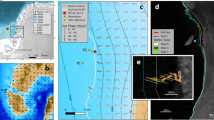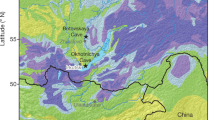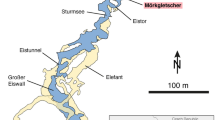Abstract
IN his interesting letter on “Snow-drifts on Ingleborough in July,” Prof. Hughes describes what may be called the first stage in the formation of a glacière. These ice-caves, not very rare in parts of the Alps and Jura, were made by the present Bishop of Bristol the subject of an attractive book (published thirty-five years ago), and have been occasionally noticed in the earlier volumes of NATURE and elsewhere. I have always believed that snow, drifted into caves during the winter, was the initial cause of these natural ice-houses (about half a dozen of which I have visited), and can quote a case from the Alps which is a slight variation of that described by Prof. Hughes. On July 24, 1873, I went up the Pic d'Arzinol (9845 feet) from Evolena in the Val d'Hérens, and on the way down—so far as I remember between five and six thousand feet above sea-level—my guide diverged from the track to show me what he called the Pertuis Freiss. These were two fissures, apparently joints, opened by a slight subsidence. A description of one will serve for both, except that there was hardly any descent to its floor. The fissure extended some four yards into the hill, and was at widest about many feet, Ice was patehed, about the, floor, and in places formed a plaster on the walls, its thickness being at most three inches. It showed prismatic structure, though rather small. The air within was cold (I had no thermometer); but as the surface of the ice was wet, it was above 32° F., though I think not much. The guide told me that the fissures in winter-time were filled with snow. This accumulation, probably owing to the shape of the fissure, no longer remained as snow, but was represented by the ice on the floor and walls, which the guide said seldom, if ever, disappeared. The absence of ice from the walls of the Ingleborough “swallow hole” was probably due to some exceptional dryness of the rock; but Prof. Hughes has undoubtedly found a “baby” ice-cave, like that I have described, and it will be worth examining some more of these dry shafts to see whether a slightly better developed specimen may not be lurking in the neighbourhood.
This is a preview of subscription content, access via your institution
Access options
Subscribe to this journal
Receive 51 print issues and online access
$199.00 per year
only $3.90 per issue
Buy this article
- Purchase on Springer Link
- Instant access to full article PDF
Prices may be subject to local taxes which are calculated during checkout
Similar content being viewed by others
Rights and permissions
About this article
Cite this article
BONNEY, T. Snow-drifts on Ingleborough. Nature 62, 412–413 (1900). https://doi.org/10.1038/062412c0
Issue Date:
DOI: https://doi.org/10.1038/062412c0
Comments
By submitting a comment you agree to abide by our Terms and Community Guidelines. If you find something abusive or that does not comply with our terms or guidelines please flag it as inappropriate.



